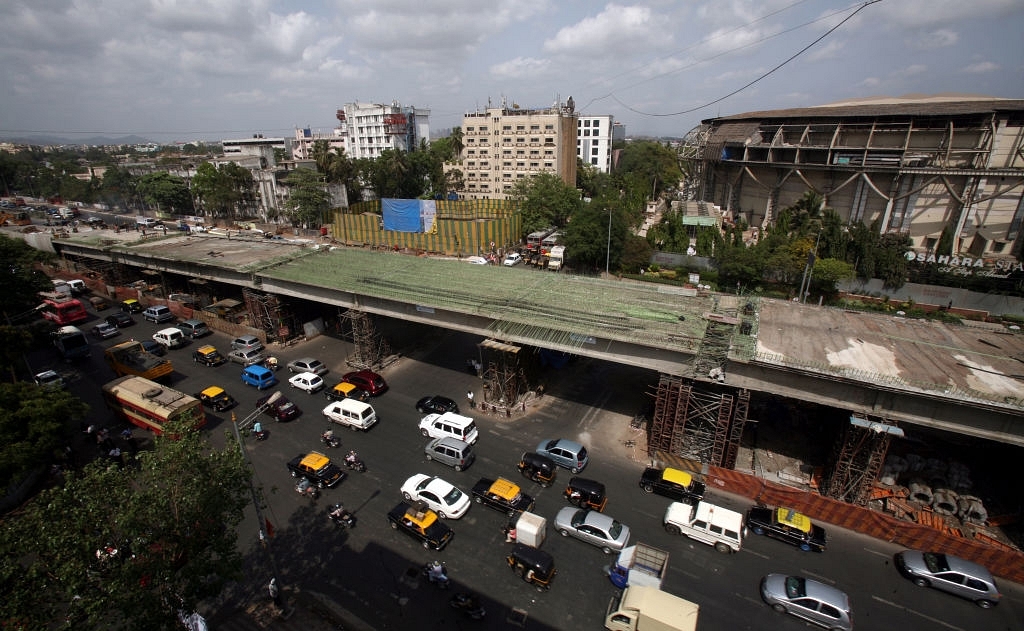Economy
How Cement Sector Will Help India Cement Its Growth In Coming Years
- What role would the cement sector play in the India growth story in the near future? A recent report by the State Bank of India may offer some clues.

Construction of flyover in progress at the domestic airport signal on the Western Express Highway. (Satish Bate/Hindustan Times via Getty Images)
Cement sector is a critical area for any country. The production and consumption of cement can give us a broad idea of overall development pace of a country as expansion of cement sector is also reflected in growth in infrastructure, housing and construction segments. As far as India is concerned, demand for cement is derived chiefly from growth in housing to the extent of 60-65 per cent. One-fourth of the demand for cement comes from infrastructure and about 10-15 per cent from commercial construction.
A report published by State Bank of India (SBI) today (7 December) on India’s cement sector gives us a holistic picture of the focus, recent developments and vast opportunities for the sector which employs a million people, directly or indirectly. Its yearly production capacity stands at 420 million tonnes (MT), production at 280 MT and consumption at 277 MT which translates into per capita consumption of 225 Kg. India is currently the second biggest cement producer in the world, accounting for 6.9 per cent of the world’s cement output.
Cement capacity, production and consumption have all witnessed overall growth in the range of 20-25 per cent in the last five years as shown in the chart below.
As the SBI report points out, recently, there have been some major investments in cement sector with Emami planning to pump in around Rs 8,500 crore in scaling up its production capacity from 2.4 MT to 15-20 MT in the next three to five years. Nirma Group has also acquired Lafarge India’s cement business with a production capacity of 11 MT.
As the report further notes, the government of India is also providing a push to the sector. In the last budget, it proposed to assign infrastructure status to affordable housing projects and facilitate higher investments and better credit facilities which is a key element of its ‘Housing For All by 2022’ project. The government is targeting to build as many as one crore houses by 2019 under Pradhan Mantri Awas Yojana, or PMAY (Gramin). Under PMAY (Urban), it plans to construct 1.2 crore units by spending Rs 185,069 crore over the next three years. Additionally, it intends to disburse loans worth Rs 20,000 crore for individual housing via National Housing Bank.
The Mumbai-Ahmedabad High Speed Rail, also known as bullet train project, will also push up demand for cement in a big way. The SBI report notes that the estimated quantity of concrete in various components of the structure is about 120 lakh cubic metre which translates into cement requirement of about 55 lakh metric tonne, and all this is to be consumed in just three years. That means this project alone will gobble up 2 MT of cement per annum during its construction phase.
On top of that, the government’s Bharatmala project will prove to be a big booster for the sector. The government intends to build 83,677 km of roads, spending Rs 6.92 lakh crore over next five years.
Gives all this, the report estimates, that India could become the main exporter of clinker and gray cement to the Middle East, Africa and other developing countries. “With help from the government in terms of friendlier laws, lower taxation and increased infrastructure spending, the sector will grow and take India’s economy forward along with it,” it concludes.
Support Swarajya's 50 Ground Reports Project & Sponsor A Story
Every general election Swarajya does a 50 ground reports project.
Aimed only at serious readers and those who appreciate the nuances of political undercurrents, the project provides a sense of India's electoral landscape. As you know, these reports are produced after considerable investment of travel, time and effort on the ground.
This time too we've kicked off the project in style and have covered over 30 constituencies already. If you're someone who appreciates such work and have enjoyed our coverage please consider sponsoring a ground report for just Rs 2999 to Rs 19,999 - it goes a long way in helping us produce more quality reportage.
You can also back this project by becoming a subscriber for as little as Rs 999 - so do click on this links and choose a plan that suits you and back us.
Click below to contribute.
Latest